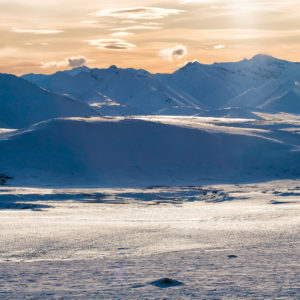Editor’s Note: For an alternative viewpoint, please see: Point: Arctic Access Essential for Energy Security
When it comes to natural wonders, the Arctic is in a league of its own. It’s the nation’s largest and northernmost wildlife refuge. It supports the greatest variety of plant and animal life of any conservation area in the circumpolar north. Groups of thousands of caribou cross into the Arctic Refuge as they complete the longest migration of any land animal in North America. Meanwhile the Arctic Wooly Bear Caterpillar, the longest-lived caterpillar on Earth, is slowly completing its seven-year transformation to a moth.
Perhaps that’s why the Arctic National Wildlife Refuge has always been not just a place, but an idea — an idea that some places should stay wild, that deep down we humans need that wild to exist, even if we never visit.
Once thought to be safely set aside, the Arctic National Wildlife Refuge now faces its greatest threats in decades, possibly ever. Like so many other basic protections once taken for granted, the Trump administration appears ready to brush aside the best, greatest, most important virtues of the Arctic refuge in a rush to unroll the welcome mat for corporate cronies.
The Trump administration, through the Department of the Interior and the agency’s leader Secretary Ryan Zinke, is pushing to allow seismic exploration in the Arctic refuge’s sensitive coastal plain. Testing brings its own set of risks, including permanent damage to the landscape. It also makes real the looming threat of drilling in the Arctic refuge. Drilling of course does not come without the sprawling industrial complex and frequent spills that have followed oil development elsewhere in Alaska and across the country.
I’ve been fortunate to visit the Arctic refuge many times. I’ve floated the braided rivers and seen grizzly bears a little too close for comfort. I’ve been reminded time again of the power of the wild as I’ve seen it through the new eyes of people from all walks of life that I’ve guided through the refuge’s wilderness. That power inspires both awe and a sense of connection that brings people together in ways our country needs more of right now.
I’ve spent time with Gwich’in people, whose subsistence and culture is tied to the caribou and who consider the coastal plain of the Arctic refuge sacred. For the Gwich’in, their way of life is inextricably linked to the health of the caribou. This makes protection of the Arctic refuge’s coastal plain a matter of their survival. I’ve been inspired by their fight to protect this place that will determine their future.
The threat is real. I’ve seen how industry edges right up to the boundary of the refuge. Oil rigs rise out of the tundra just about a dozen miles from the edge of the Arctic refuge. And President Trump is looking to stack the deck at the Department of Interior with officials who view the coastal plain of the Arctic refuge with dollar signs in their eyes. Congress, too, is eying revenue from drilling in the Arctic refuge as part of a budget package.
At the same time the Arctic is warming twice as fast as the rest of the world. Changing temperatures threaten the fragile balance created by the extremes of the place, and the people and wildlife who depend on it. Shifting migration patterns and receding sea ice threaten the food security of Alaska’s Native people. New oil and gas drilling, anywhere, will only worsen the problem.
The Arctic National Wildlife Refuge is one of America’s last wild places, and the coastal plain is its biological heart. If the Arctic refuge isn’t special enough to save, then no place is safe from oil rigs. And if we lose the wild — whether near or far, we will have lost some part of ourselves.

